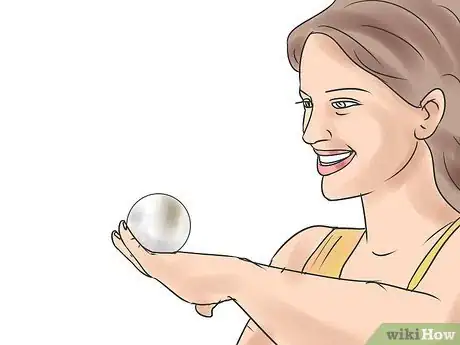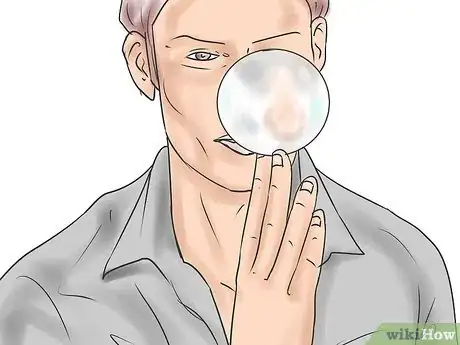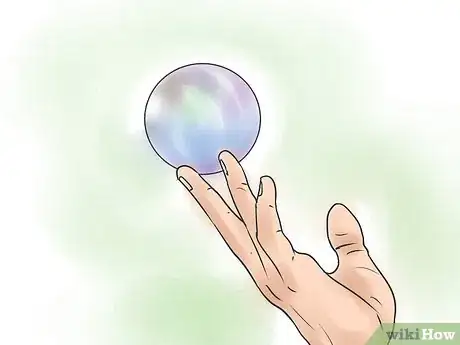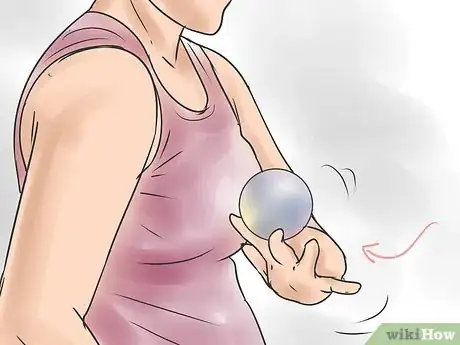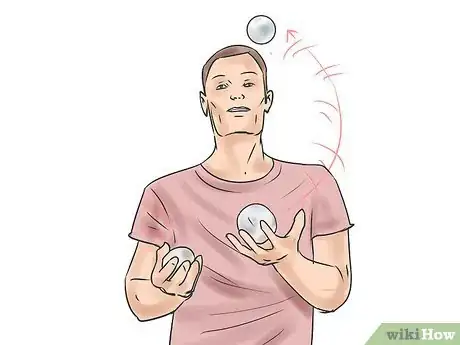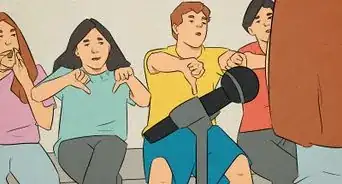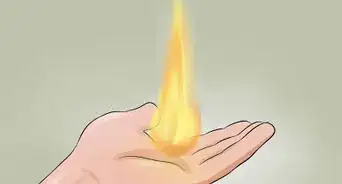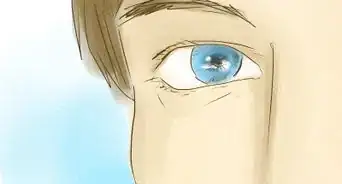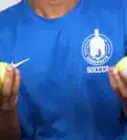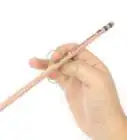wikiHow is a “wiki,” similar to Wikipedia, which means that many of our articles are co-written by multiple authors. To create this article, 40 people, some anonymous, worked to edit and improve it over time.
wikiHow marks an article as reader-approved once it receives enough positive feedback. In this case, 91% of readers who voted found the article helpful, earning it our reader-approved status.
This article has been viewed 323,010 times.
Learn more...
Contact Juggling is a style of single or multiple ball manipulation also called Dynamic Manipulation and Sphereplay, seen repeatedly in the movie Labyrinth. A practiced contact juggler will eventually be able to roll, spin, toss and pass the ball back and forth, looping and bobbing it over the fingertips, palms, the tops of the hands, arms and other parts of the body in a graceful dance.
Steps
-
1'The Cradle. Hold your favored hand out, palm down with fingers extended and touching. Dip the straightened middle finger down slightly to make a cradle for the ball. Place and leave the ball on top of the fingers near the second knuckles of the first, middle and ring fingers. Keep it there for several minutes at a time to get used to it. Move your hand around, up and down as the ball is cradled on top of it, adjusting for inertia. Find the cradle on the tops of both your hands and become very accustomed to the ball being there. This is intrinsic to contact juggling.[1]
-
2Palm to Cradle Over the Edge (transfer)– Hold the ball in your open palm, set on the upper, meaty part between the third and second knuckles. Now, keeping the fingers together and straight (but not tense), give the ball a very slight lift up and pivot your open hand inwards, still underneath the ball so that it rolls over the outer edge of your index finger and lands in the cradle position on the top of your hand. Hold it a few moments. Now rotate it back to your palm with the opposite pivoting motion, dropping the plane of your hand back down if you need to. Practice until the ball moves as little as possible while your hand moves under it. Eventually there will be "sweet spots" where you instinctively feel it and perform the move effortlessly.Advertisement
-
3Palm to Cradle Over the Tips (transfer)– Again, set the ball in the open palm as in step 2 but this time the ball will roll over the fingertips rather than the edge of the index finger. Hold the ball in your open palm with the fingers together and gesturing towards ten o'clock (left) or two o'clock (right), depending on which hand you're starting with (it should look like you’re about to shrug with one arm). Then, using your elbow for a counterbalance (get your upper arm working, too), steadily swing your open palm in towards you with a windshield-wiper, arching kind of motion and let the ball roll over the tips of the fingers (just between the first and middle fingers) and on to the cradle position (top of the hand). Once the ball comes to rest on the cradle, pivot/swing your arm in the same arc back to the starting position and allow the ball to pass back over the fingertips to the palm. The ball should ultimately go over without the fingers being spread too far apart, but get them further apart and make an actual track for awhile if you need to. You can also try learning this transfer with the ball first cradled in front of you and arc it out to the palm.[2]
-
4The Butterfly – This is the previous palm-to-cradle-fingertips transfer done back and forth rhythmically so that the ball travels in a fluid figure-eight or windshield wiper motion as it glides to-and-fro. The only difference is that your elbow should be free to move around a lot more to support a fluid motion. To get a well-rounded figure-eight, lift the ball in a small, inward curve from your palm as the ball passes over it back to the cradle. Start off slowly and deliberately so you can get used to the move and watch it. The butterfly looks its best, though, when done snug and sleek. Once you've really got it, try reversing the direction of the figure-eight.[3]
- On the outward motion of the butterfly (when the ball rolls on to the palm) be sure not to cup or grasp the ball before you roll it back over to the cradle. Even when in the palm, the ball should be visible.
- Mastery of the butterfly leads to more flashy, intermediate moves such as the top to top butterfly pass.
-
5Beyond - Many more transfers and passes exist and there are also isolation's: keeping the ball in one fixed spot in space while the hands grab, hold and flourish around it as the ball appears to hover. There are also arm rolls, elbow stalls, chest rolls and (for some very talented folks indeed) head, neck, back and shoulder rolls. Practiced contact jugglers also do many types of palm spinning, rotating multiple balls in the hands. The list goes on; if you can picture it, it can probably be done.
Warnings
- Keep your distance from others. Try not to "transfer" the ball into your lip, nose or forehead and don't start with acrylic. It is not fragile like glass and will break tiles, aquariums, knick-knacks and bones before it will break itself.⧼thumbs_response⧽
- Acrylic balls create a lens that can easily burn. Don't leave a clear (or translucent) contact ball out where it might be exposed to sunlight, or you may find burnt holes in whatever surface the ball was resting on.⧼thumbs_response⧽
- There are some in the juggling community who have chosen to snub this art for various reasons. Visit the first three External Links below to learn more about the ethical debates surrounding it.⧼thumbs_response⧽
- If you're practicing and sitting Indian-style, cover your ankles with something like a blanket or extra socks or your ankles may end up very black and blue from accidental drops.⧼thumbs_response⧽
- Do it next to your computer and you will be sorry. If it accidentally falls out it WILL crack the screen or outer shell.⧼thumbs_response⧽
Things You'll Need
- The Ball: Start with a nice, round orange, a light wooden ball or a stage ball (3"/7.6 cm to 4" /10.2 cm wide). Don't be afraid to drop it over and over. Practice over a bed or in the grass. Later on, when you're dropping the ball less, an acrylic juggling ball(3" /7.6 cm or 4" / 10.2 cm) works well for most. The balls can easily be found on websites by searching for "contact juggling".
